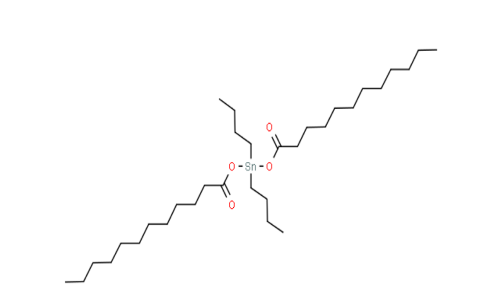Dibutyltin Dilaurate (abbreviated DBTDL), also called dibutyltindilaurate or butynorate, is an organotin compound that is used as a catalyst. It is a colourless oily liquid. It's known for improving how plastics connect, especially in the production of polyurethanes. Because it helps with the efficiency of making plastics, Dibutyltin Dilaurate is used by industries looking for high-quality plastics.

| CAS Number: | 77-58-7 |
| UN Number: | 3082 |
| Hazard Class: | 9 |
| Packing Group: | III |
Physical properties of Dibutyltin Dilaurate
Safety information for Dibutyltin Dilaurate
All safety information can be found in our downloadable information guides. For specific queries about the properties of Dibutyltin Dilaurate or your concerns, please speak to the East Harbour Group team.
FAQs
Dibutyltin Dilaurate is commonly used as a catalyst in various chemical processes, particularly in polymerisation reactions. Its application is prominent in the production of polyurethanes, where it serves to enhance the cross-linking of polymers. The catalyst facilitates the formation and strengthening of chemical bonds in polyurethane materials, contributing to improved material properties and product performance.
Polyurethanes, derived with the help of Dibutyltin Dilaurate, find applications in a wide range of industries, including construction, automotive, coatings, adhesives, and more. The catalyst's role in promoting polymerization efficiency makes it valuable in the creation of high-quality polymer-based formulations.
Hazard Class 9, as defined by various transportation regulations such as the United Nations Globally Harmonized System of Classification and Labelling of Chemicals (GHS), pertains to miscellaneous dangerous substances and articles. These are materials presenting a hazard not covered by other specific classes. Class 9 encompasses various hazardous goods, including environmentally hazardous substances, elevated temperature materials, and miscellaneous hazardous items that may pose risks during transportation.
Examples may include lithium batteries, asbestos, and magnetised materials. Proper classification, labelling, and packaging are crucial when dealing with Hazard Class 9 materials to ensure safe handling, transport, and storage, as well as to provide essential information to emergency responders and regulatory authorities.
To safely handle and store the substance, ensure good ventilation, comply with legal requirements, and use personal protective equipment. Avoid contact with skin, eyes, and inhalation. Clean contaminated clothing, store it in a closed container away from heat sources and follow local regulations. Seek special instructions before use, measure air concentration regularly, and conduct operations in well-ventilated areas. Wash hands after handling, segregate working clothes, and do not eat, drink, or smoke during use.
Take precautionary measures against static discharge, store in a cool, dry, well-ventilated place, and lock up as per regulations. Adhere to legal requirements for packaging, labelling, and securing fragile containers. Regularly check compliance with storage rules.
Dispose of the substance in compliance with local legislation, avoiding disposal of domestic waste. Follow the sorting instructions provided by a licensed collector for both the contents and the container. Refrain from discharging the substance into drains or the environment to ensure environmentally responsible disposal practices.
IF YOU WANT TO LEARN MORE ABOUT HOW EAST HARBOUR GROUP LTD CAN HELP YOUR BUSINESS, GET IN TOUCH.
